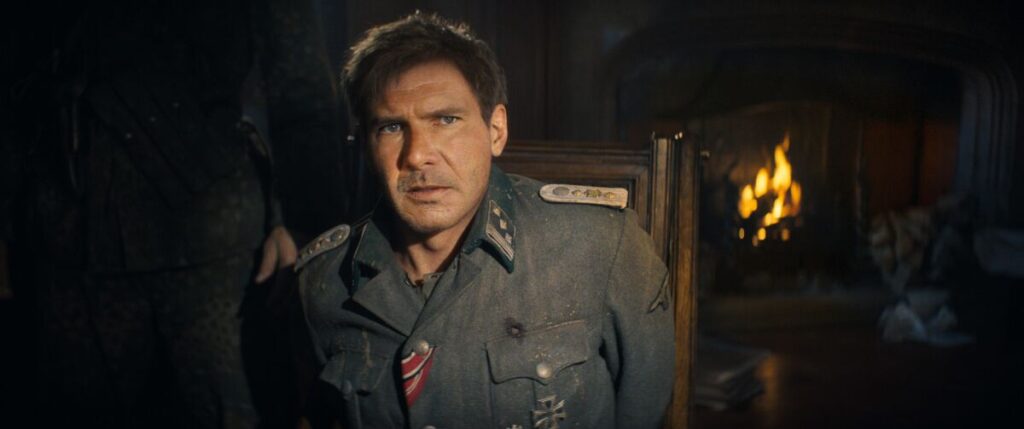“Indiana Jones and the Dial of Destiny” premiered Thursday night at the Cannes Film Festival and Times film critic Justin Chang and culture critic Mary McNamara were there, walking the red carpet, watching Harrison Ford tear up as he accepted an unexpected honorary Palme d’Or and, most importantly, reuniting with one of cinema’s most iconic adventure heroes, Henry “Indiana” Jones. Who, like the rest of us, is a bit older than he was when we saw him last. That, of course, was the big question going into the fifth Indiana Jones film, 15 years after its predecessor: Are Indy, and the franchise, past their prime? Should it have been called “Indiana Jones and the Curse of the Ancient Sequel”?
Mary McNamara: Though it will doom me among cinephiles everywhere, I confess that “Dial of Destiny” is the reason I came to Cannes. Well, that and the fact that my editor asked me to. Fly across a continent and a slew of sleep-fracturing time zones to get a first look at the return of my beloved Indy? You bet. Was I afraid I’d be disappointed? Absolutely. I saw “Indiana Jones and Kingdom of the Crystal Skull”; I knew the risks.
Mercifully, the franchise’s rule of odd and evens held true: “Dial of Destiny” joins the pantheon of “Raiders of the Lost Ark” and “Indiana Jones and the Last Crusade,” and not just because there were so many fine and fun references to each of those films. It’s impossible to re-capture the thrill of the original, but not only does “Dial” hold its own as an adventure tale, it is less a trip down memory lane than a contemplation of the dangers of nostalgia, which is pretty cheeky, when you think about it.
A de-aged Harrison Ford in a scene from “Indiana Jones and the Dial of Destiny.”
(Lucasfilm Ltd./Lucasfilm Lt)
Justin Chang: Mary, if this cinephile is being honest, “Dial of Destiny” is the reason I’m most grateful you came to Cannes. (Well, that and your splendid company.) Will it doom me in your eyes to learn that I was born just two years after “Raiders of the Lost Ark” came out and somehow managed to avoid watching it until I got to college? (“Temple of Doom” and “The Last Crusade” took me even longer.) Since you are, by several rickety suspension bridges, the bigger Indiana Jones fan/expert between us, I’m happy to play the novice to your sensei as we run down what we just saw.
And what did we see? Something that, while I may not be as eager to usher it into the pantheon, certainly clears the low bar set by “Kingdom of the Crystal Skull.” I saw that fourth series entry here at Cannes back in 2008, to similarly overwhelming levels of applause and nostalgia, but the movie was an expensive mediocrity that I haven’t re-watched or thought much about since. Truth be told, I’m not sure how much I’ll think about or re-watch “Dial of Destiny,” either, though if forced to choose between the two 21st-century Indy sequels, Phoebe Waller-Bridge certainly trumps a creaky blown-up fridge.
McNamara: Screw you for being born after “Raiders of the Lost Ark,” and for not bothering to watch my biggest screen crush until you were in college. But you’re right about Waller-Bridge; as Indy’s goddaughter, Helena Shaw, she is an absolute gift. Quick with a comeback and a left hook, she is Indy’s (and Ford’s) equal in every scene and flips the trope of the woman as romantic interest/pesky hanger-on — often clad only in lingerie — that plagued the earlier moves.
Which are resurrected in the opening scenes, where a magically made-young Ford, as Indy, takes us back to World War II. The titular dial, a potentially time-traveling device created by Archimedes, is acquired, lost and acquired again. Much of the action takes place on a train — always a good sign! — and it’s shot in a way to openly evoke nostalgia. Even Mads Mikkelsen as the Nazi scientist Jürgen Voller looks a bit youth-enhanced. Indy is, if not precisely his old self, a very reasonable facsimile, punching out Nazis and pausing only to verify ancient artifacts.
The prolonged “flashback” makes the transition to 1969 both reassuring and jarring. We meet up with our hero as full-bore cranky old geezer. It’s hilarious but also depressing; director James Mangold and team of screenwriters lean into the realities of time on myriad levels, and though we see Indy come back to life in certain ways, the film does not shy away from the fact that life is not something you come back from so much as move through.
It’s daring for a 42-year old franchise to play with the notion that one can never really go back in time, even as it does so narratively and literally. Though all the Indiana Jones touchstones are there — antiquities, chases through windy streets in improbable vehicles, rickety bridges, even the dreaded snakes, there’s a weight to this film that was absent from the others, which felt quite earned to me.
Chang: I found that World War III flashback prologue by turns fascinating, transporting and a little creepy. Ford has noted in interviews that the digital de-aging process involved artificial intelligence, which was used to pull images of his younger face from across the entire Lucasfilm archive, including from unused footage, which is why the overall effect is so seamless. Perhaps A.I. — a subject of much discussion in Hollywood these days — can be the villain next time around: “Indiana Jones and the Horrors of ChatGPT.” Then again, given how annoyed fans were by “Crystal Skull’s” most unwelcome pivot into science fiction, maybe better not.
This conversation will continue updating live from the Cannes Film Festival.

